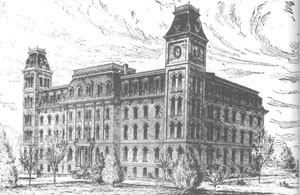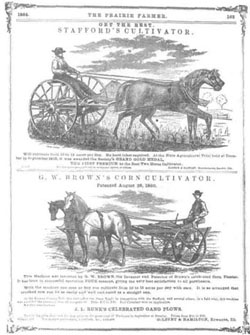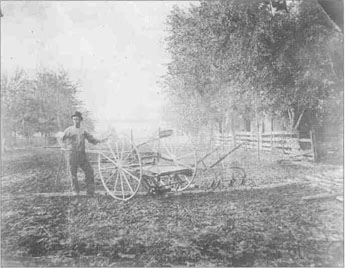 |
Home | Search | Browse | About IPO | Staff | Links |
 |
Home | Search | Browse | About IPO | Staff | Links |
|

David R. Wrone How often do we encounter vital institutions in our lives and think them common, part of the way society is and ever was. Yet so often these ordinary elements of great merit and immeasurable worth were not part of the original construction of society, but were created with much effort by our ancestors, sometimes in the face of much opposition. Our universities are an instance. The public university emerged in Illinois after a difficult social struggle. Its history illustrates how a particular group of people transplanted an important idea from a particular culture and germinated it in Illinois. In 1862, as the result of a hard-fought land-grant college movement, Congress passed the

University Hall, frontispiece for Sixteenth Report of the Board of Trustees (1892), University of Illinois, Champaign, Illinois
42
Morrill Land-Grant Act funding a system of public universities. The resulting funds enabled Illinois in 1867 to charter the University of Illinois, the parent public college of our present system. Every major civilization we know of has had some form of higher education, although it varied considerably. The Greeks of classical antiquity, ancient China, classical Timbuktu, East Africa, Israel, Sumer, Inca, Aztec, Egypt, and Medieval Europe all had groups of highly educated individuals who supported, maintained, and advanced society and culture. In the era of colonial America, European nations — England, France, Holland, the Germanies, Poland, Spain, and others —already supported public and religious colleges or similar institutions, and some of them were hundreds of years old. European class and privilege systems restricted enrollment to members of the privileged classes. Immigrants brought to American colonies the idea of the university. The colonists did not establish public colleges but rather created a number of small religious schools—Yale, Harvard, William and Mary, Brown, and Princeton— whose curricula intended to educate men, not women, to become primarily preachers, teachers, lawyers, and physicians. After Americans formed a constitutional government in 1789, the first generation of American leaders considered establishing a national public university based on democratic principles and modeled after the European form, but took no action. For example, President George Washington recommended the creation of a national university. In the 1780s the national effort turned away from higher education and took the form of encouraging common or primary schools. The federal government awarded to the states section sixteen of each township from the public domain to be used for schools, a remarkable act of the new republic to provide education for the common citizens. In 1818, when Illinois entered the union, Congress added a condition to the funds it normally gave new states by decreeing that Illinois set aside a small percentage of the proceeds from the sale of federal land to be "exclusively bestowed on a college or university." Eventually, in 1857, Illinois used the small accrued sum to establish the State Normal School in the new town of Normal, near Bloomington, to prepare teachers for the common schools. By 1850 Illinois had passed through the frontier stage, entering the era when industry began to dominate society. Four types of education existed. With self-education, perhaps best typified by Abraham Lincoln's life, one gained the rudiments of reading, writing, and arithmetic largely outside a school system with the help of a few books and the aid of a friend, parent, or neighbor. Some children were educated in one-room public school houses such as the small log school at Funk's Grove. A handful of students attended private institutions of higher education, typified by Illinois College at Jacksonville, a small religious school. Many of the leading men and women of the state had attended few Illinois colleges or migrated from the East, where they had attended private sectarian colleges. Some adults continued to enhance their education, thereby encouraging the spread of ideas, by reading in their private libraries. Personal libraries were often found in the homes of the wealthy, who modeled them
43
after the ideal of Thomas Jefferson or James Monroe. Wealthy central Illinoisians Clifton Moore of Clinton, James Millikin of Decatur, and David Davis of Bloomington had extensive personal libraries. But so did some ordinary folk such as the sheriff of DeWitt County, who in 1860 died leaving a small classical library. In the 1850s the sweeping industrial revolution shook Illinois, bringing the railroad, telegraph, improved newspapers, better markets for farm products, better bridges, the state's first factories, financial sophistication, and the growth of large cities. With that great transformation also came the influx of immigrants from Europe and migrants from the eastern and southern states to work the farms and fill the cities. The old subsistence farm that had marked Illinois agriculture from its beginning started to give way to the new order of market economy. That new dynamic world demanded more knowledge than students typically acquired in the common schools. In the midst of that change and growth, a vigorous movement emerged in the nation and in Illinois to establish a national system of public colleges. Part of the motivation arose from the general idea of democracy that firmly held education to be the key to a better life. Democracy asserts that each citizen possesses by nature an innate intelligence and good abilities. Those attributes require only that natural elements be enhanced by education to enable citizens to participate more fully in society. Consequently, adherents believed that education ought to be public. Many educational reformers believed that the small sectarian colleges offered little subject matter useful to contemporary Americans. Finally, the idealists sought a college system that would be more practical and oriented to the pressing demands of the new industrial order.
Before public colleges could come into existence, reformers had to formulate the idea, disseminate it, and test it by discussion and debate in state and national arenas. It is impossible to determine who in America first expressed the idea of a system of public colleges financed by the federal government financing through grants of land from the public domain. Many individuals appear to have been thinking about it. The idea, so to speak, was in the air. Though Illinois' experience in the public college movement represents just part of the picture, it must be underscored, because for the idea to be ultimately successful at the national level, it would have to have support at the state level. Illinoisians played an important role in the reform, giving speeches, distributing publications, lobbying government leaders, and pushing the doctrines into many states. In Illinois, the first important appearance of the idea for a public university system was at the Putnam County Farmers' Convention held in the Granville Presbyterian Church on November 18, 1851. Called by the Buel Institute, an area reform group, "to take steps toward the establishment of an agricultural university," the convention discussed the question thoroughly. After the assemblage had adopted a resolution to "take immediate measures for the establishment of a University in the State of Illinois", Jonathan Baldwin Turner delivered a carefully prepared speech that incorporated the ideas of several persons advocating the development of public colleges. He later published it as a pamphlet, "Plan for an Industrial University of the state of Illinois." 44 Turner, a Yale graduate, had migrated to Illinois from Massachusetts. A professor at Illinois College in Jacksonville, he also farmed and lectured and agitated widely on a variety of social subjects. For two years or so prior to the Granville meeting he had spoken without success on the necessity of establishing an industrial university to address the practical requirements of agriculture and industry. Turner's typical speech described the failure of existing private universities trapped in the old ideals that college ought to be concerned with the study of Latin and Greek languages and ancient authors. Colleges did not address the practical concerns of life, especially agriculture. Turner stressed the democratic basis of American society, explaining that a people's institution was needed to sustain it. Turner then outlined what the university could do for farmers and the industrial classes. Four months later, when the progressive and widely read Prairie Farmer weekly in Chicago published Turner's speech, he had added the critical component that such colleges should be funded by federal grants of land. They would be called land-grant colleges. But there was strong opposition to the public university system. Turner's barn and outbuildings were burned. A number of newspapers railed against the foolishness of what seemed like a Utopian idea and a perfect waste of money. Many farmers—and most Illinois farmers—believed no results would flow from such an institution that it would actually provide a way for its students to avoid hard, practical work with their hands. Farmers had to be convinced to support the movement. The timing of Turner's speech galvanized reformers. Two organizations contributed significantly to the success of the land-grant college — the Buel Institute, made up of a group of progressive farmers from the five counties of north central Illinois, and the Illinois Industrial League. The two groups employed a variety of tactics aimed at convincing the United States Congress to pass a land-grant university bill. In an era when persons heavily relied on letter writing to communicate and discuss ideas, proponents corresponded with men of influence throughout the state and with key individuals in other states. The Illinois Industrial League printed the pamphlet, "Industrial Universities of the People," which included the text of Turner's November 18 speech, petitions to the legislature, and extracts from the press. Widely distributed and read, the document provided a central reference for reformers and sympathizers. The reformers also wrote and placed articles in local and statewide newspapers, worked at conventions of farmers and political groups for resolutions in support of the idea, and lobbied the Illinois legislature. Reformers established a statewide lecture system with spokesmen promoting the idea to local citizens and organizations. Finally, to influence Congress, they utilized

45
the right to petition under the constitution and organized numerous drives for petitions that they presented to Congress. One of the principal supporters of the idea was the editor of the Prairie Farmer, John S. Wright, who used the pages of the popular farm journal to agitate for an industrial university. Wright had migrated from Massachusetts to Chicago, where he had become involved in a number of social improvement projects.

Other leaders fought hard to bring the idea of the public university to fruition in Illinois. From 1845 to 1858 Bronson Murray lived in Ottawa. A wealthy farmer and owner of several farms, he had been born in New York City, received a fine education, and had inherited his farms. On the prairies he actively supported Turner, helped finance some of the projects, originated many novel and attention-getting ideas, and served as a key figure in the Industrial League. After 1859 he returned to New York, but in later years returned to Illinois to make his home near his farms in Odell and Pontiac. Dr. John A. Kennicott moved into Northfield, in Cook County, in 1836. A medical doctor from New York by way of New Orleans, he had ridden the medical circuit of the prairies to treat the sick. He belonged to the Industrial League and was a tireless correspondent and activist. Dr. Reuben C. Rutherford migrated to Illinois from Vermont. His occupation was not uncommon in those days; he was a lecturer who spoke throughout Illinois on topics connected with human physiology. He added the creation of the industrial university to his lecture topics. Leonard Bullock, born and educated in Massachusetts, farmed in LaSalle County and supported the cause. William A. Pennell, a Vermont native and President of the Buel Institute, was a farmer and officer in the Industrial League who spoke widely on the topic. He later moved to Normal to educate his six daughters and was a co-worker with Jesse W. Fell of Bloomington. John P. Reynolds who migrated from Ohio and farmed near Chicago was active in agricultural societies. Ralph Ware, originally from Massachusetts, farmed near Granville and was a member of the Industrial League. His family had built the Granville Presbyterian Church. Jesse Fell from Bloomington, had been born in Pennsylvania. A land owner, lawyer, land speculator, and celebrated local boomer, he vigorously supported the idea, and desperately wanted the land-grant university to be located at Bloomington. Turner performed an important additional role. In addition to speaking tirelessly and corresponding extensively on the topic, he lobbied both Stephen A. Douglas and Abraham Lincoln. Each assured him that if elected president he would sign a bill establishing a land-grant college system. Partly because of Lincoln, the idea would find support in Washington. At the national level, support for land-grant universities increased. The idea gripped the mind of Justin Morrill, a Congressman from Vermont, who had extensively discussed the issue and gave it his distinctive stamp. On December 14, 1857, he introduced House Bill No. 2 establishing a land-grant college system. It passed both the House of Representatives and the Senate, only to be vetoed on February 26, 1859, by President James Buchanan, who objected to it on fiscal and constitutional grounds. Morrill persisted and the Illinois reformers continued their work. On December 16, 1861, Morrill reintroduced the bill as House Bill No. 138, which 46
was sent to the House Committee on Public Lands for a hearing chaired by Representative John Fox Potter of Wisconsin, a man who detested the idea. On May 29, Potter's committee reported out the bill negatively. On the House floor, supporters tried to move it in a Committee of the Whole in order to override the committee report, but they were defeated. Then the superb political skills of the bill's supporters came into play. As Potter stymied the bill in committee, reform politicians took an alternative course. Senator Benjamin Franklin Wade of Ohio introduced Senate Bill No. 298, an identical version of Morrill's bill, which was sent to the Senate Committee on Public Land. On May 16 it reported out the bill favorably. On June 10, 1862, it passed the Senate 32 to 7 and was sent to the House to be considered. On June 17 on the House floor, Representative Morrill called up Senate Bill No. 298 for debate and vote. Representative Potter's committee could not block it by procedural methods. It passed 90-25. On July 2, 1862, as Union armies retreated from a bloody defeat at Malvern Hill, and the nation faced a dark future, Lincoln signed the remarkable bill into law. For the purpose of establishing a college, the Morrill Land-Grant Act provided each state with 30,000 acres of land for each member it had in Congress. States in rebellion were excluded, and the bill required the teaching of military tactics. Since Illinois had sixteen congressional representatives, it was awarded 480,000 acres of public land to be sold and the income used for college. On February 14, 1863. the Illinois legislature accepted the grant. Then came a fierce, four-year political struggle over where to locate it. Champaign won. The University of Illinois has grown to become one of the premier world universities. The Morrill Act established sixty-nine colleges and dramatically expanded many existing small colleges throughout the nation. It was revolutionary. No other nation on earth had ever before created a system of public higher education. In the years to come, the University of Illinois directly and indirectly provided billions of dollars of economic benefit to the state and nation, indeed to the world. University educators have developed inventions, new techniques, and methods, made important discoveries, provided leadership not only in agriculture but in other areas, helped raise the quality as well as the standard of living, and enlightened the minds of six generations of students. Certainly the university's history has quietly proven the merit of citizen assumption of responsibility for the integrity of society, the need for constructive criticism of the established order, and the importance of reform for the attainment of civic well-being in a constitutional democracy. Click Here for Curriculum Materials
47
|
|
|